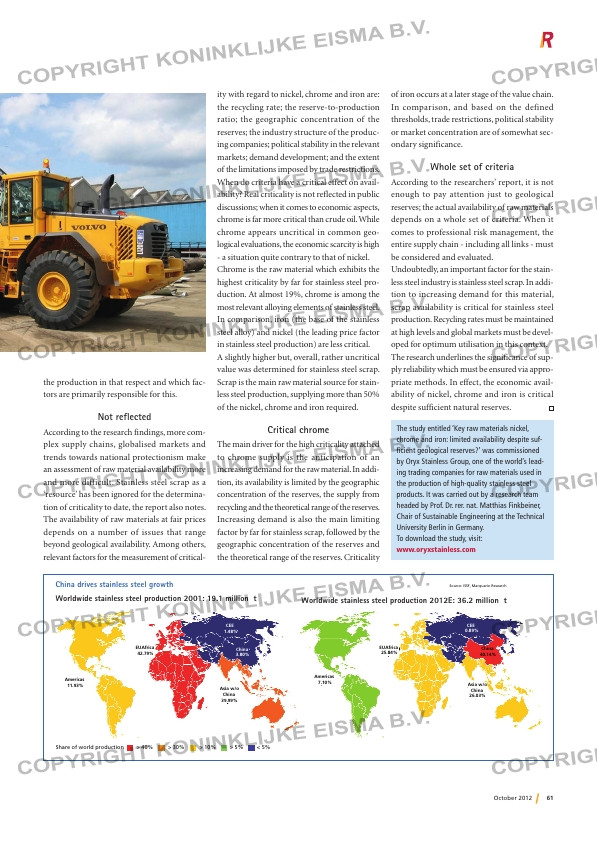Page 61 from: October 2012

61October 2012
the production in that respect and which fac-
tors are primarily responsible for this.
Not reflected
According to the research findings, more com-
plex supply chains, globalised markets and
trends towards national protectionism make
an assessment of raw material availability more
and more difficult. Stainless steel scrap as a
‘resource’ has been ignored for the determina-
tion of criticality to date, the report also notes.
The availability of raw materials at fair prices
depends on a number of issues that range
beyond geological availability. Among others,
relevant factors for the measurement of critical-
The study entitled ‘Key raw materials nickel,
chrome and iron: limited availability despite suf-
ficient geological reserves?’ was commissioned
by Oryx Stainless Group, one of the world’s lead-
ing trading companies for raw materials used in
the production of high-quality stainless steel
products. It was carried out by a research team
headed by Prof. Dr. rer. nat. Matthias Finkbeiner,
Chair of Sustainable Engineering at the Technical
University Berlin in Germany.
To download the study, visit:
www.oryxstainless.com
China drives stainless steel growth
Worldwide stainless steel production 2001: 19.1 million t Worldwide stainless steel production 2012E: 36.2 million t
Source: ISSF, Macquarie Research
Share of world production > 40% > 30% > 10% > 5% < 5%
Americas
11.93%
EUAfrica
42.79%
Asia w/o
China
39.99%
Americas
7.10%
EUAfrica
25.84%
CEE
1.48%
China
40.14%
CEE
0.89%
Asia w/o
China
26.03%
China
3.80%
ity with regard to nickel, chrome and iron are:
the recycling rate; the reserve-to-production
ratio; the geographic concentration of the
reserves; the industry structure of the produc-
ing companies; political stability in the relevant
markets; demand development; and the extent
of the limitations imposed by trade restrictions.
When do criteria have a critical effect on avail-
ability? Real criticality is not reflected in public
discussions; when it comes to economic aspects,
chrome is far more critical than crude oil. While
chrome appears uncritical in common geo-
logical evaluations, the economic scarcity is high
– a situation quite contrary to that of nickel.
Chrome is the raw material which exhibits the
highest criticality by far for stainless steel pro-
duction. At almost 19%, chrome is among the
most relevant alloying elements of stainless steel.
In comparison, iron (the base of the stainless
steel alloy) and nickel (the leading price factor
in stainless steel production) are less critical.
A slightly higher but, overall, rather uncritical
value was determined for stainless steel scrap.
Scrap is the main raw material source for stain-
less steel production, supplying more than 50%
of the nickel, chrome and iron required.
Critical chrome
The main driver for the high criticality attached
to chrome supply is the anticipation of an
increasing demand for the raw material. In addi-
tion, its availability is limited by the geographic
concentration of the reserves, the supply from
recycling and the theoretical range of the reserves.
Increasing demand is also the main limiting
factor by far for stainless scrap, followed by the
geographic concentration of the reserves and
the theoretical range of the reserves. Criticality
of iron occurs at a later stage of the value chain.
In comparison, and based on the defined
thresholds, trade restrictions, political stability
or market concentration are of somewhat sec-
ondary significance.
Whole set of criteria
According to the researchers’ report, it is not
enough to pay attention just to geological
reserves; the actual availability of raw materials
depends on a whole set of criteria. When it
comes to professional risk management, the
entire supply chain – including all links – must
be considered and evaluated.
Undoubtedly, an important factor for the stain-
less steel industry is stainless steel scrap. In addi-
tion to increasing demand for this material,
scrap availability is critical for stainless steel
production. Recycling rates must be maintained
at high levels and global markets must be devel-
oped for optimum utilisation in this context.
The research underlines the significance of sup-
ply reliability which must be ensured via appro-
priate methods. In effect, the economic avail-
ability of nickel, chrome and iron is critical
despite sufficient natural reserves.
R _8- in .indd 61 09-10-12 10: 9



